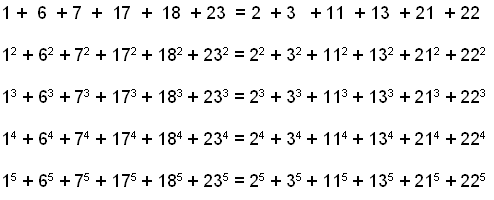
Science & Math
Turnabout

Two business partners asked their lawyer to hold $20,000, making him promise to get both of their signatures before disbursing any of it.
As soon as one partner left town, the other pressed the lawyer for $15,000, citing an emergency. The lawyer reluctantly gave it to him, and he disappeared.
On his return, the other partner was irate, so the lawyer explained that he had donated the $15,000 out of his own pocket.
“Then give me the $20,000 you’re holding,” said the partner.
“All right,” said the lawyer. “Give me the two signatures.”
Math Notes
24 + 14 + 74 + 84 = 6514
64 + 54 + 14 + 44 = 2178
Infinite Composition
In Tristram Shandy, the title character laments that he’ll never be able to finish his autobiography, as he seems to need a year to record each day’s events. “It must follow, an’ please your worships, that the more I write, the more I shall have to write.”
But Bertrand Russell noted that if Shandy’s eventful life had lasted forever, no part of his biography would have remained unwritten — for the hundredth day would be recorded in the hundredth year, the thousandth in the thousandth, and so on. “This paradoxical but perfectly true proposition depends upon the fact that the number of days in all time is no greater than the number of years.”
Feedback
Rest the ends of a yardstick on your index fingers. Now slowly draw your fingers together, trying to make them meet at some spot other than the center of the stick.
It’s impossible. When either finger leads, it bears more weight, which creates more friction, and the other catches up.
Math Notes
651 × 156 = 372 × 273
The Kruskal Count

Here’s a card trick devised by Rutgers physicist Martin Kruskal. Give a friend a deck of cards and ask her to follow these instructions:
- Think of a “secret number” from 1 to 10. (Example: 6)
- Shuffle the deck and deal the cards face up one at a time, counting silently as you go.
- When you reach the secret number, note the value of that card and adopt it as your new secret number. Aces count as 1; face cards count as 5. (Example: If the 6th card is a 4, then 4 becomes your new secret number.)
- Continue dealing, counting silently anew from 1 each time you adopt a new number. Remember the last secret card you reach.
That’s it. You just stand there and watch her deal. When she’s finished, you can identify her final secret card in any way you please, preferably through a grotesquely extortionate wager.
You can do this because you’ve simply played along. When she’s dealing, note the value of an early card and then silently follow the same steps that she is. Five times out of six, your “paths” through the deck will intersect and your final secret card will match hers. That’s far from obvious, though; the trick can be baffling if you refuse to explain it.
Kaprekar’s Constant
Choose four distinct digits and arrange them into the largest and smallest numbers possible (e.g., 9751 and 1579). Subtract the smaller from the larger to produce a new number (9751 – 1579 = 8172) and repeat the operation.
Within seven iterations you’ll always arrive at 6174.
With three-digit numbers you’ll aways arrive at 495.
Math Notes
410 + 610 + 710 + 910 + 310 + 010 + 710 + 710 + 710 + 410 = 4679307774
Confirmed
Abraham de Moivre correctly predicted the date of his own death.
He noted that he was sleeping 15 minutes longer each day and surmised that he would die on the day he slept for 24 hours. That date, he calculated, would be Nov. 27, 1754.
He was right.
